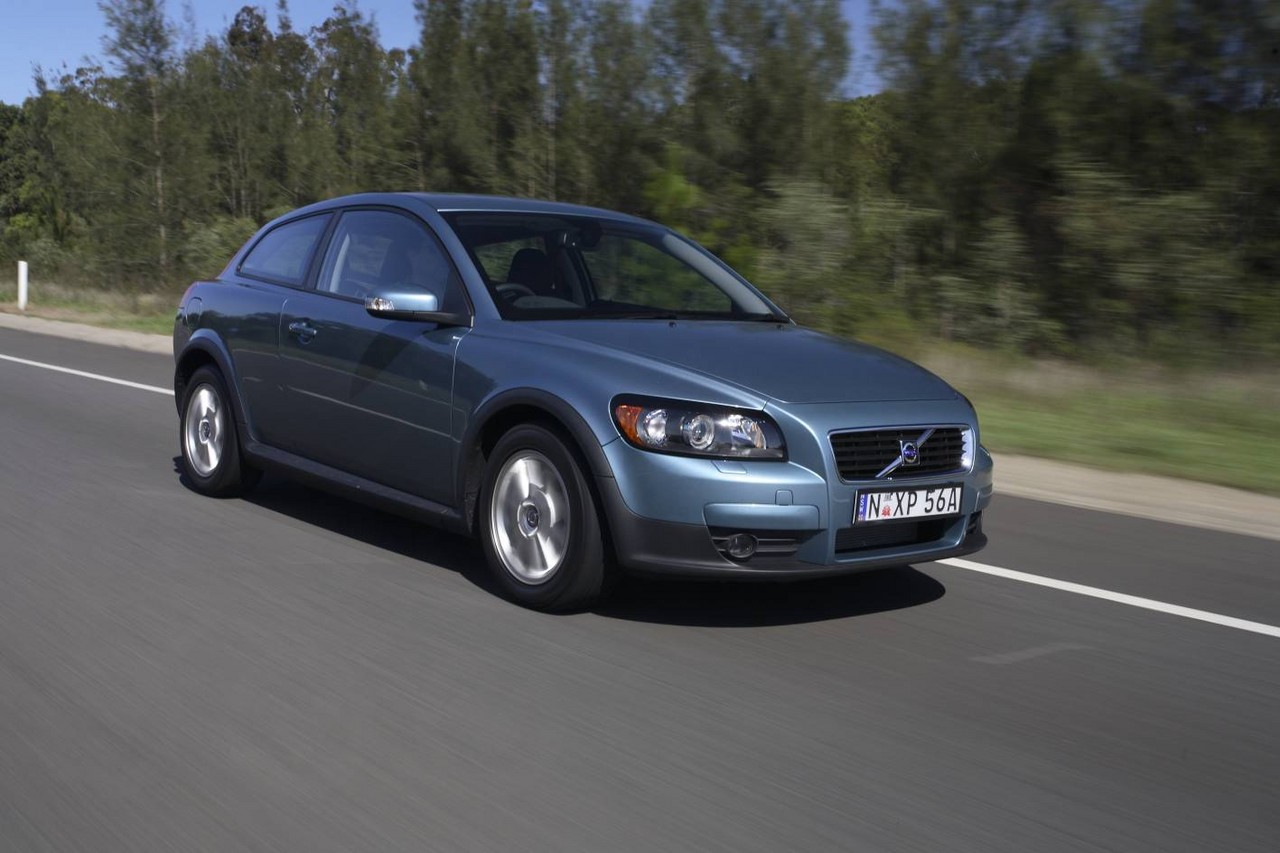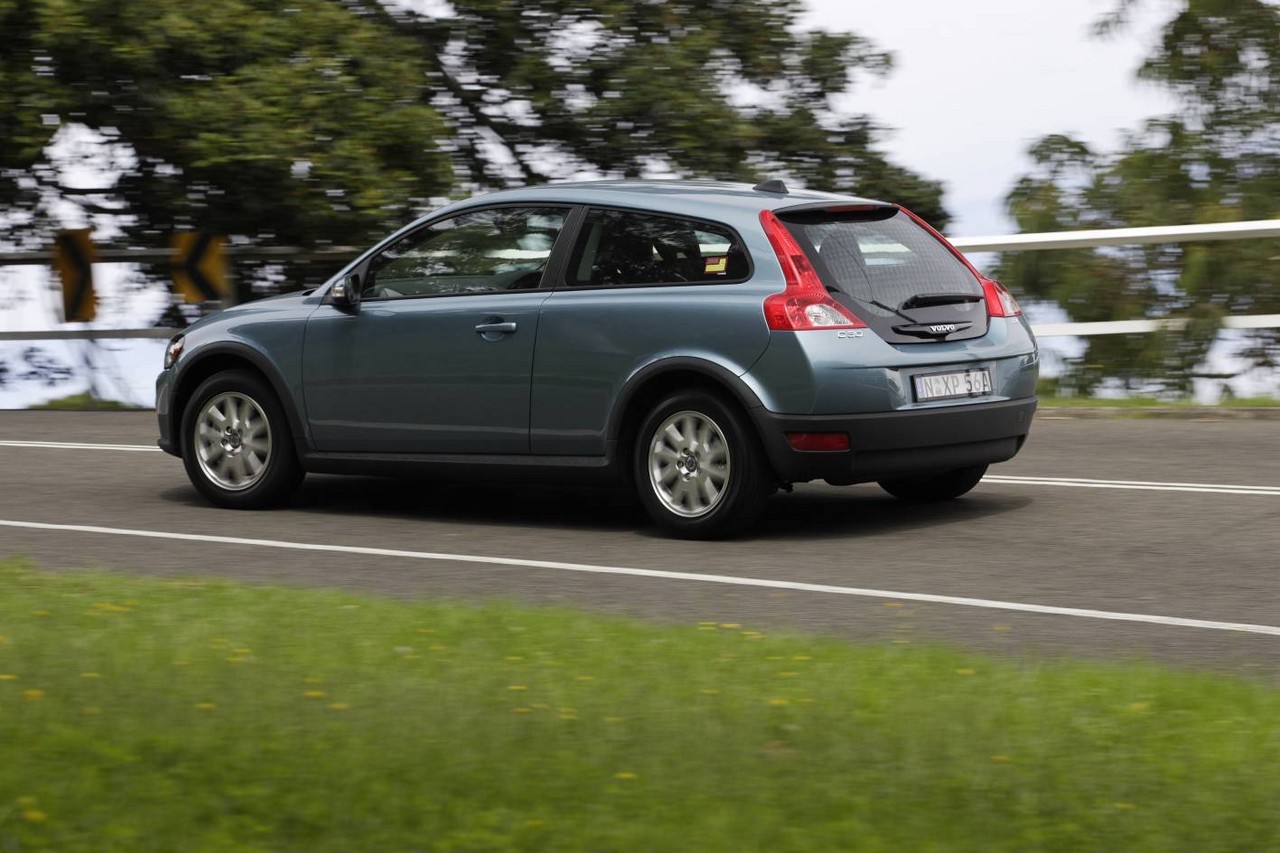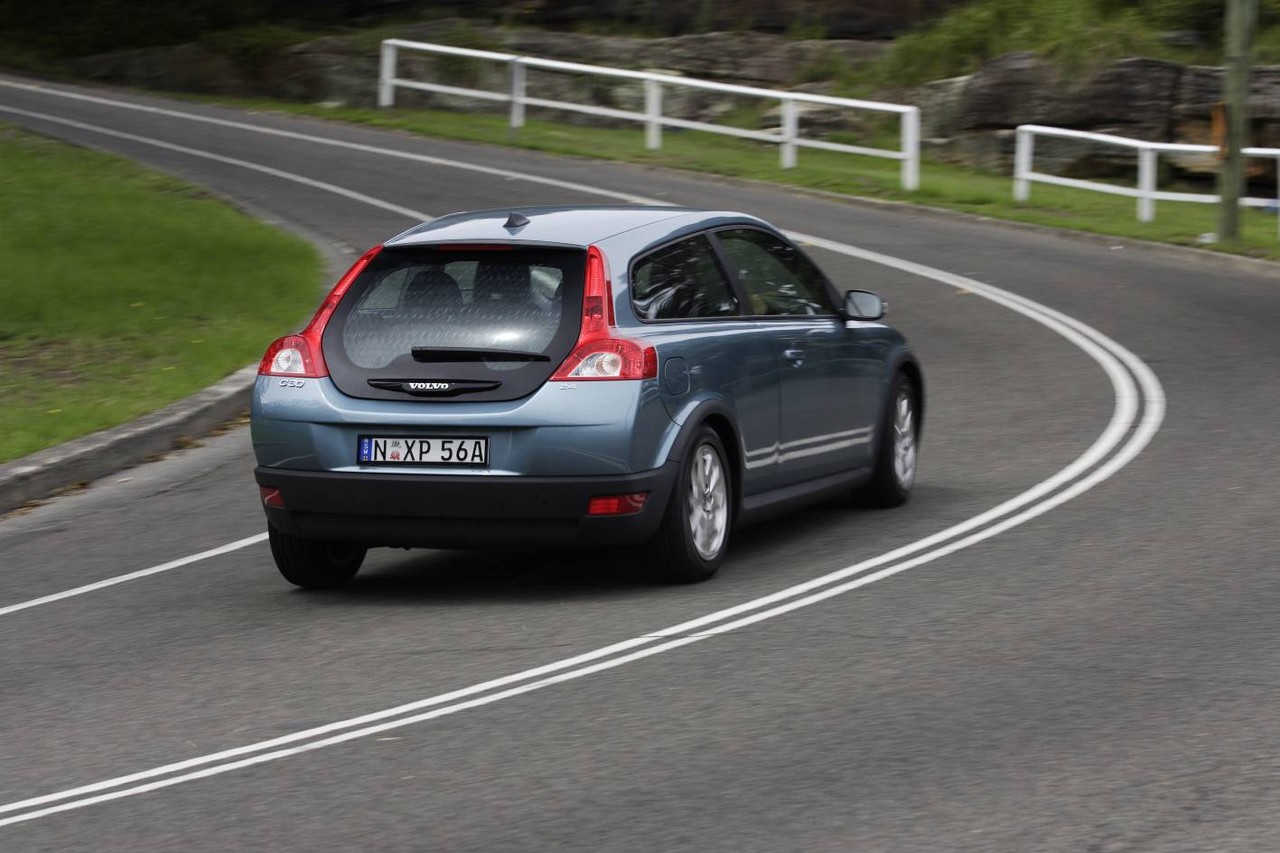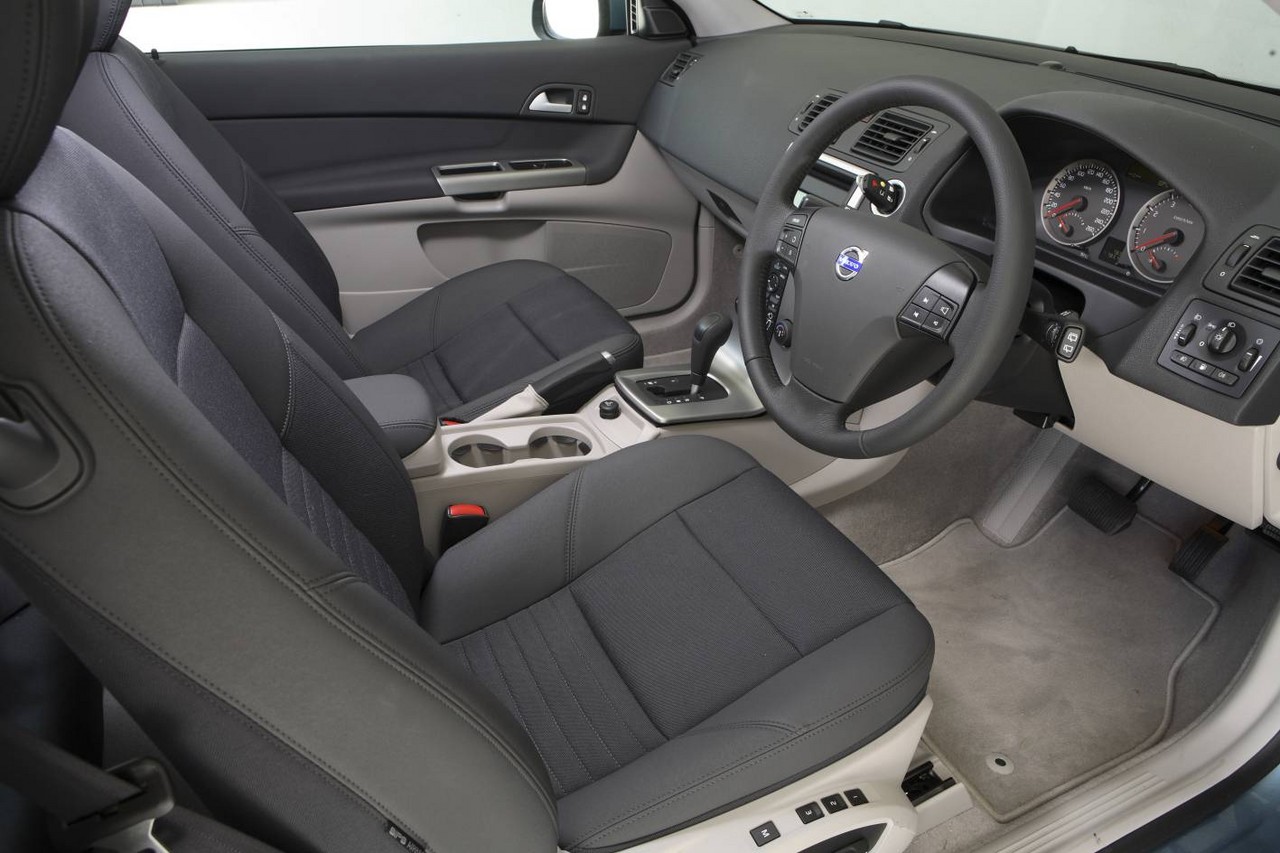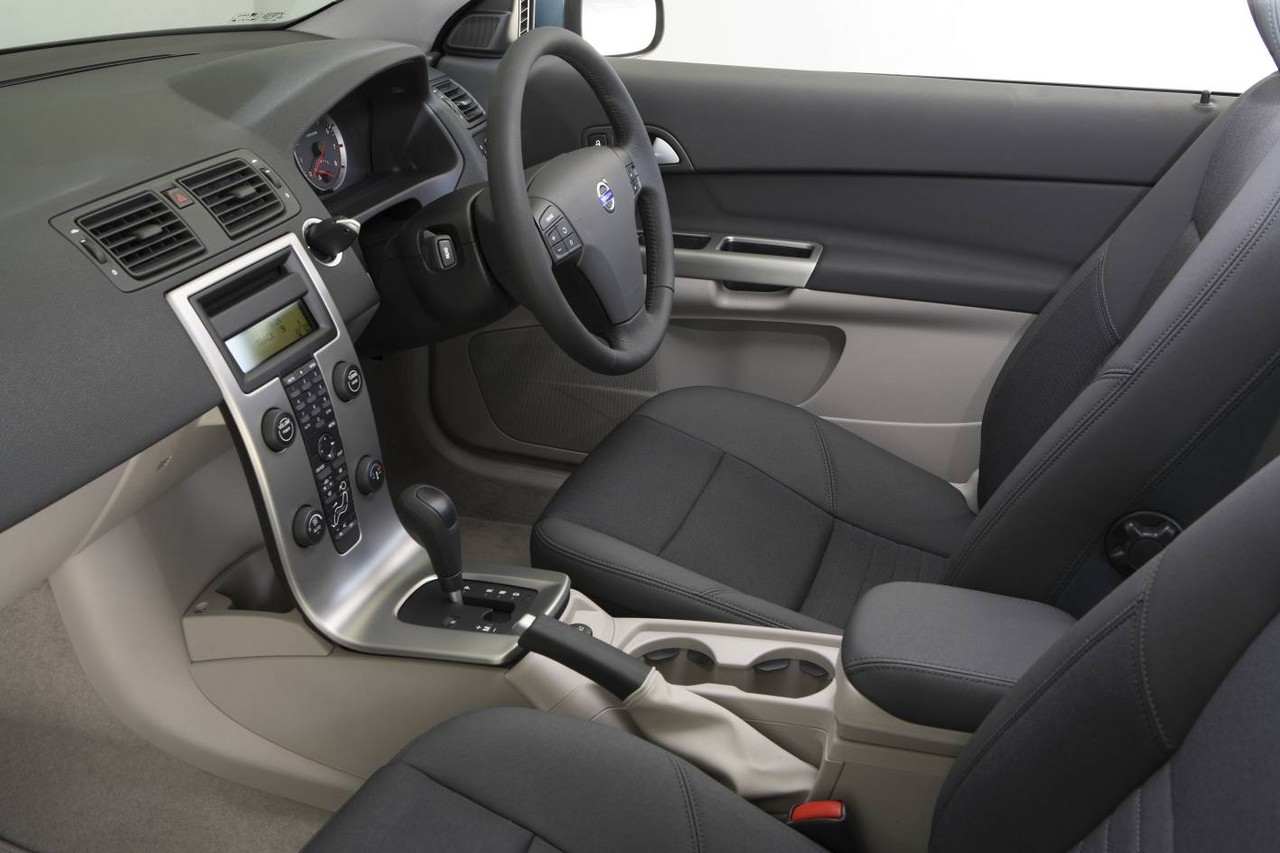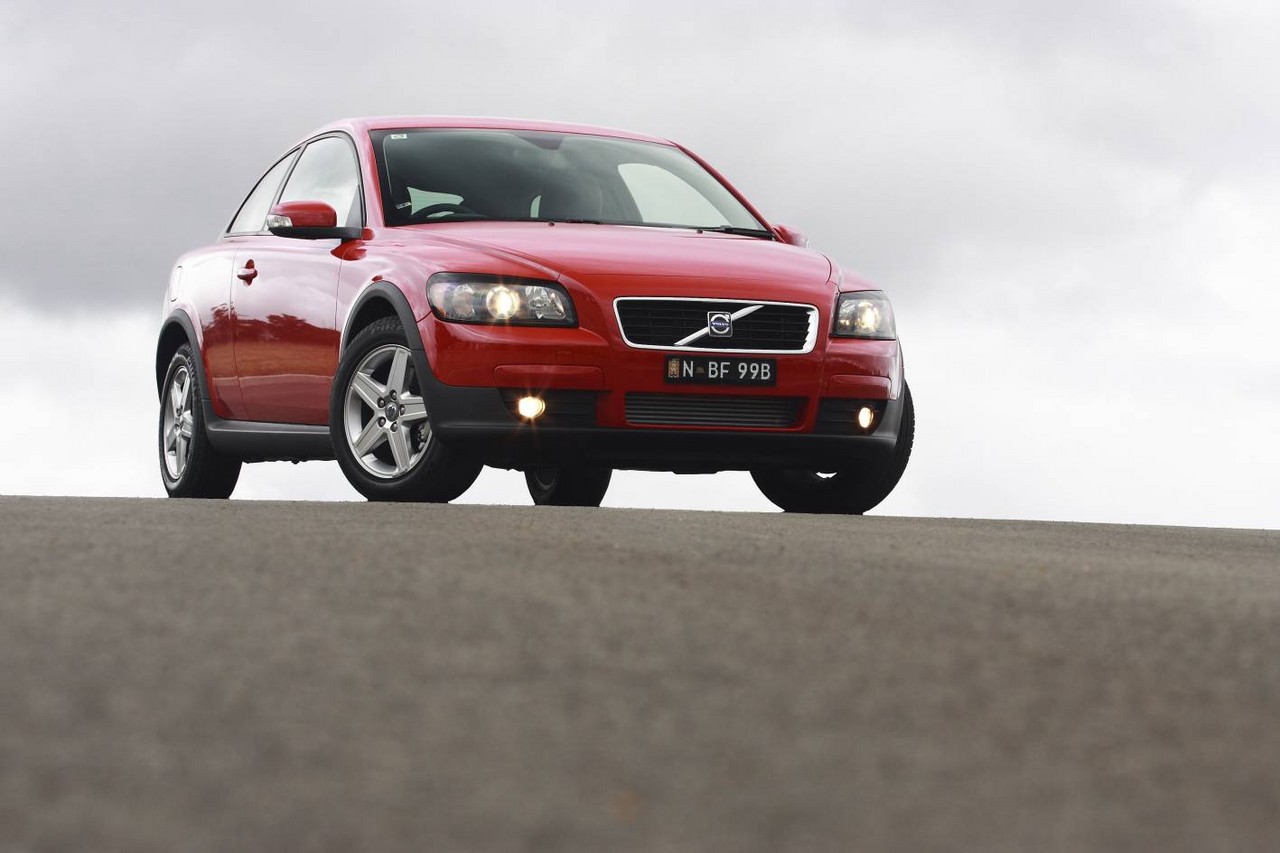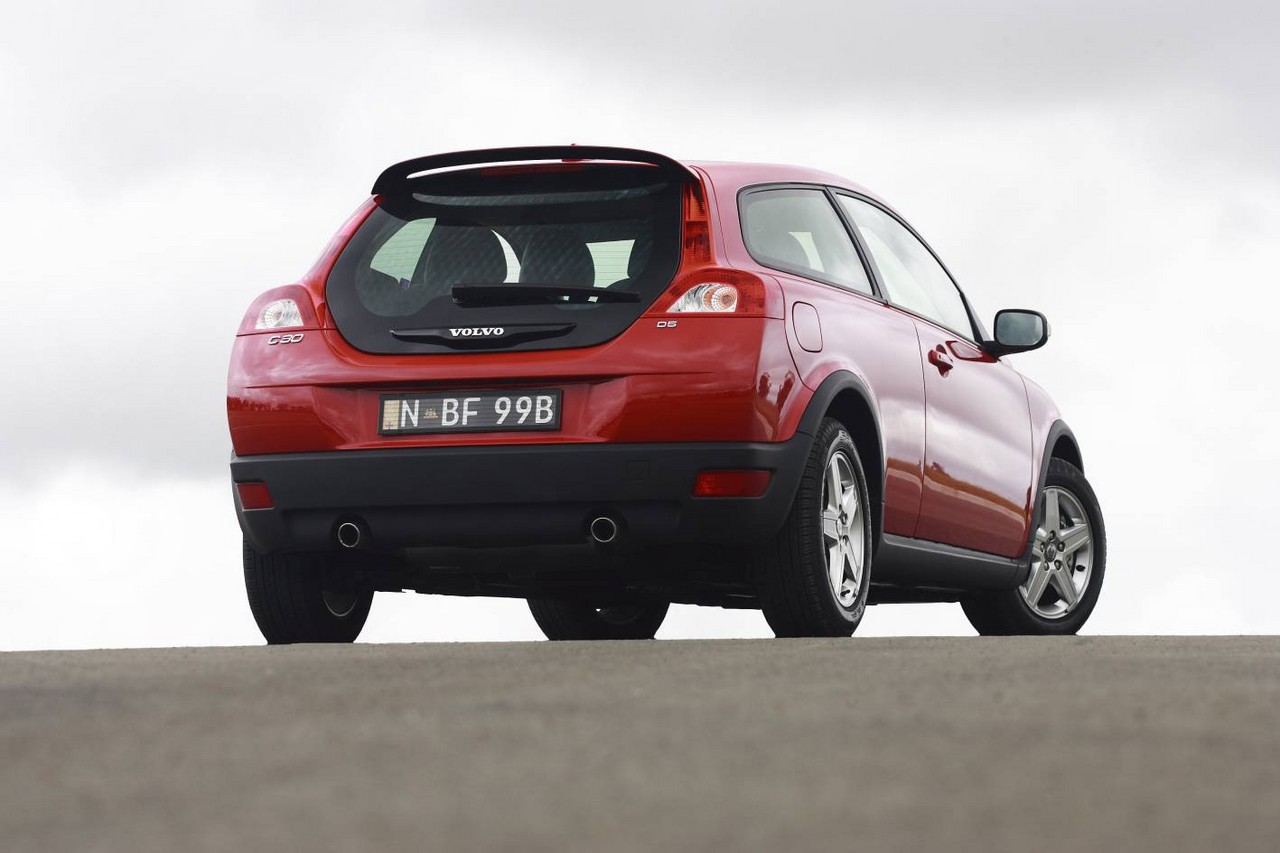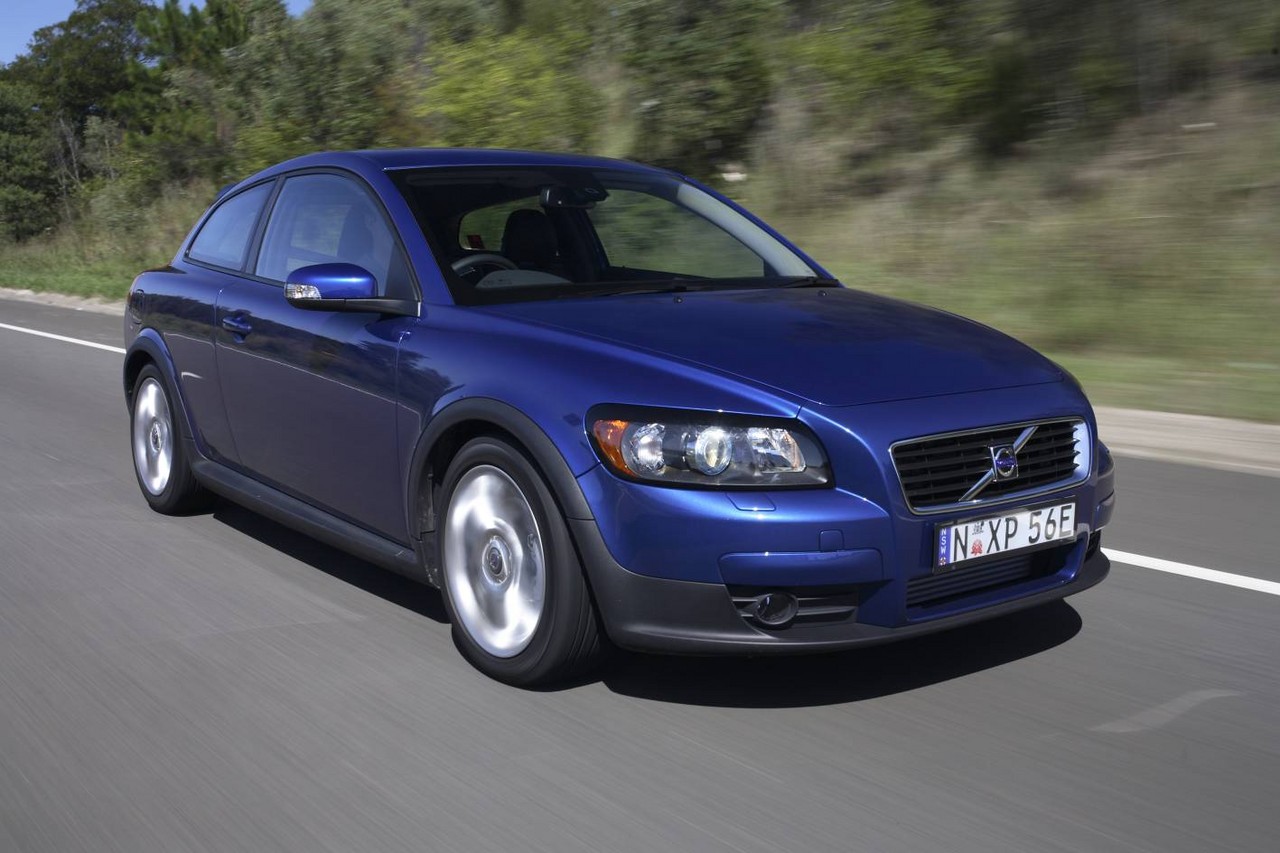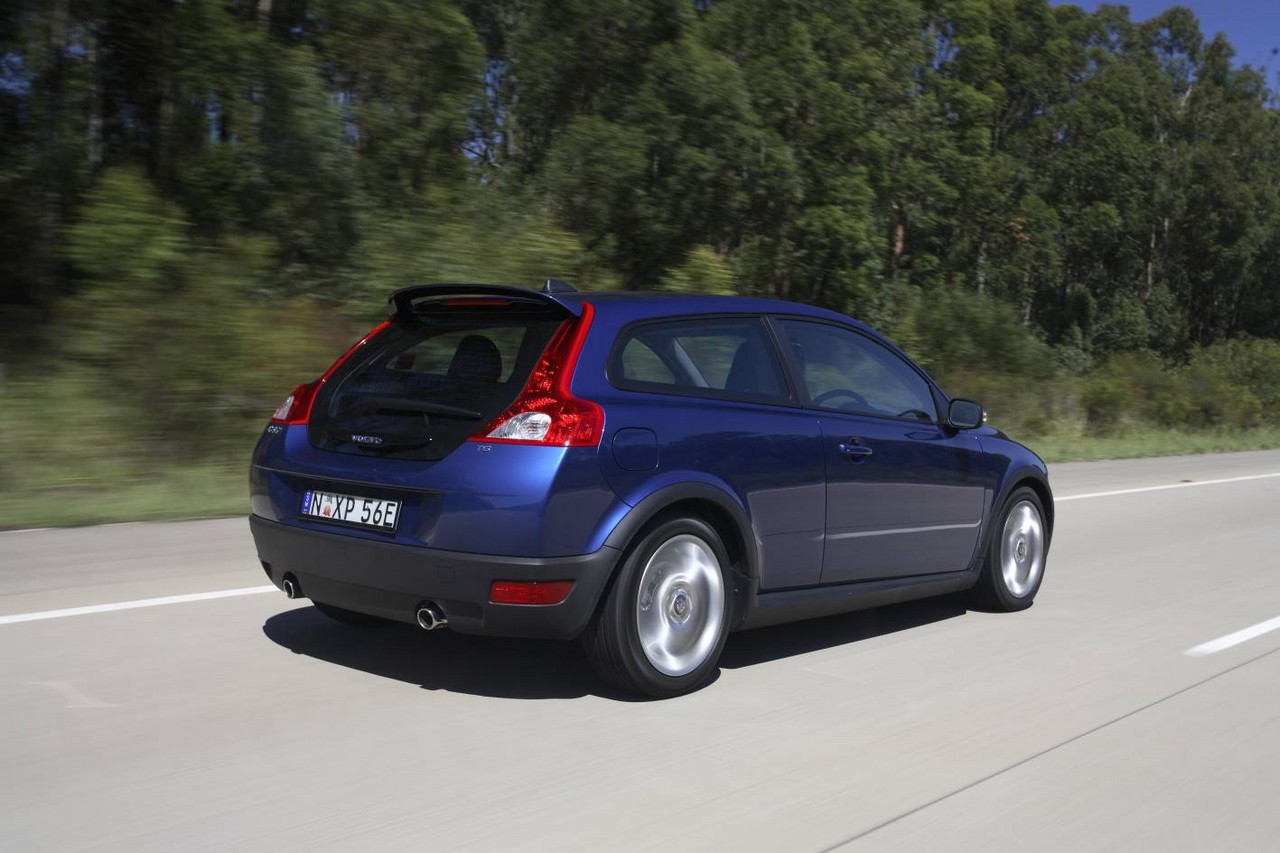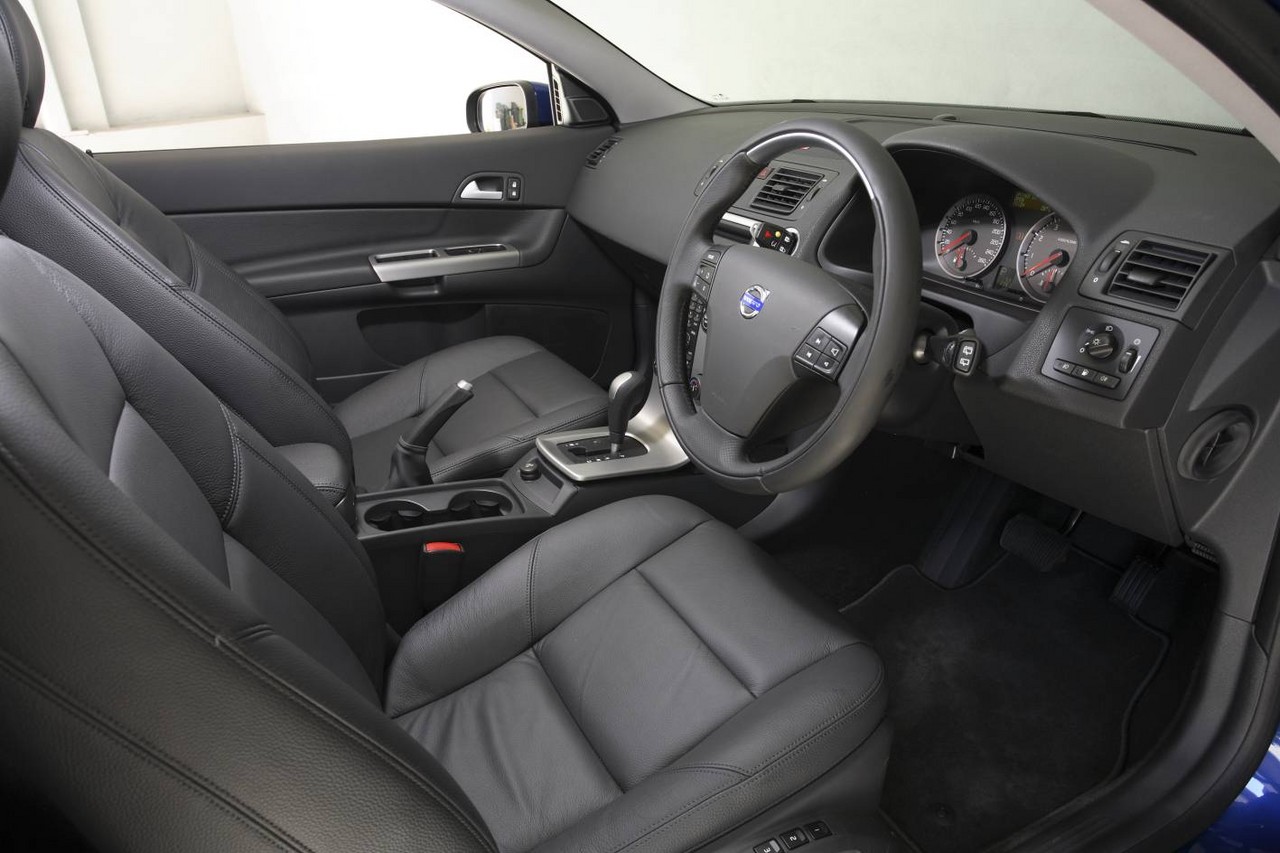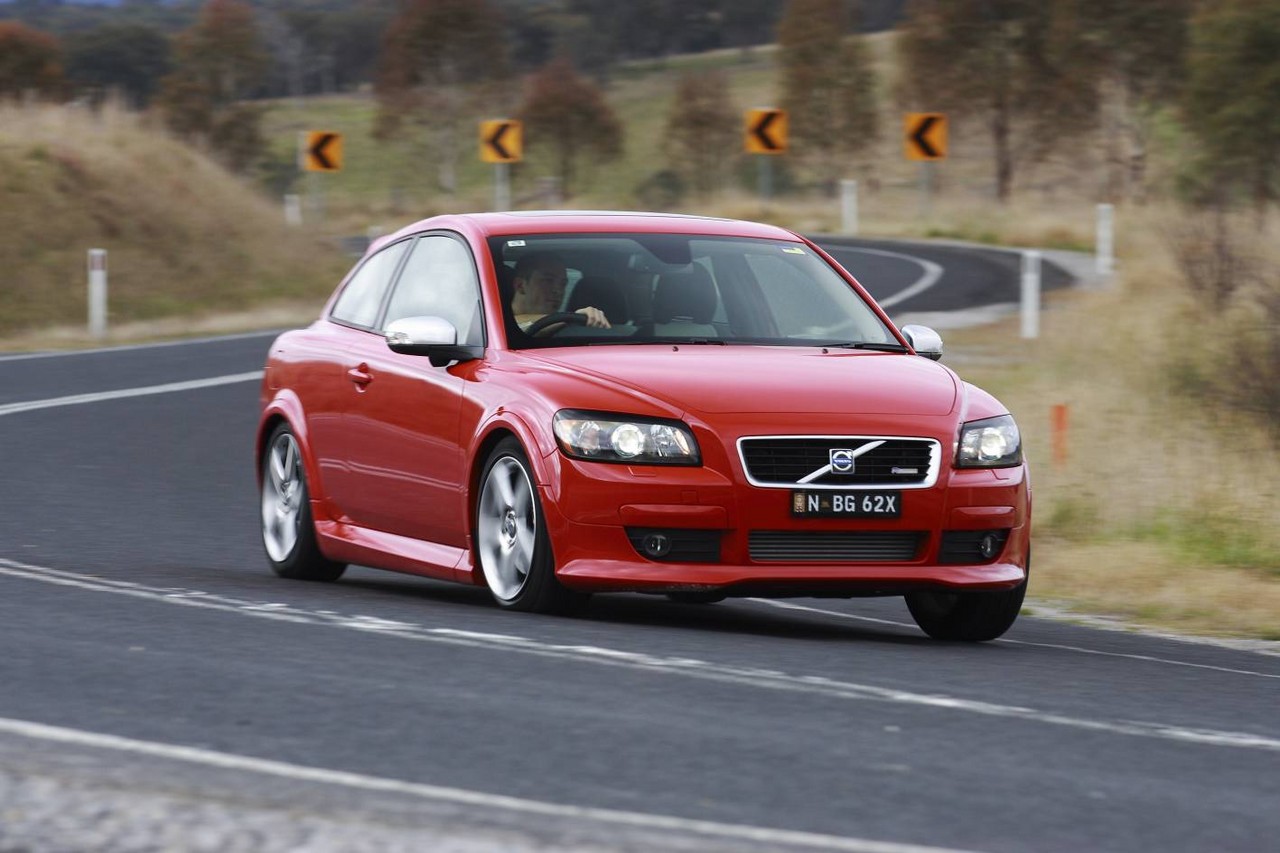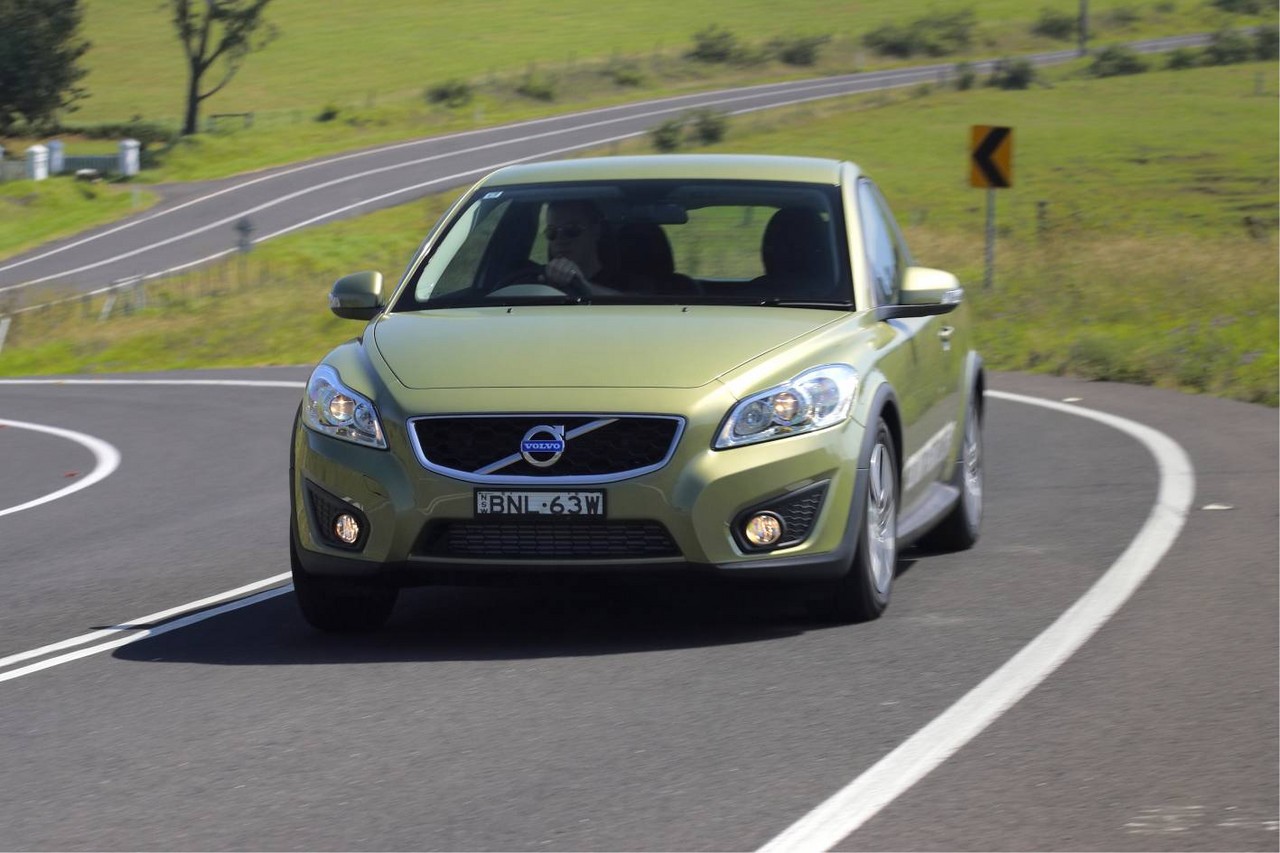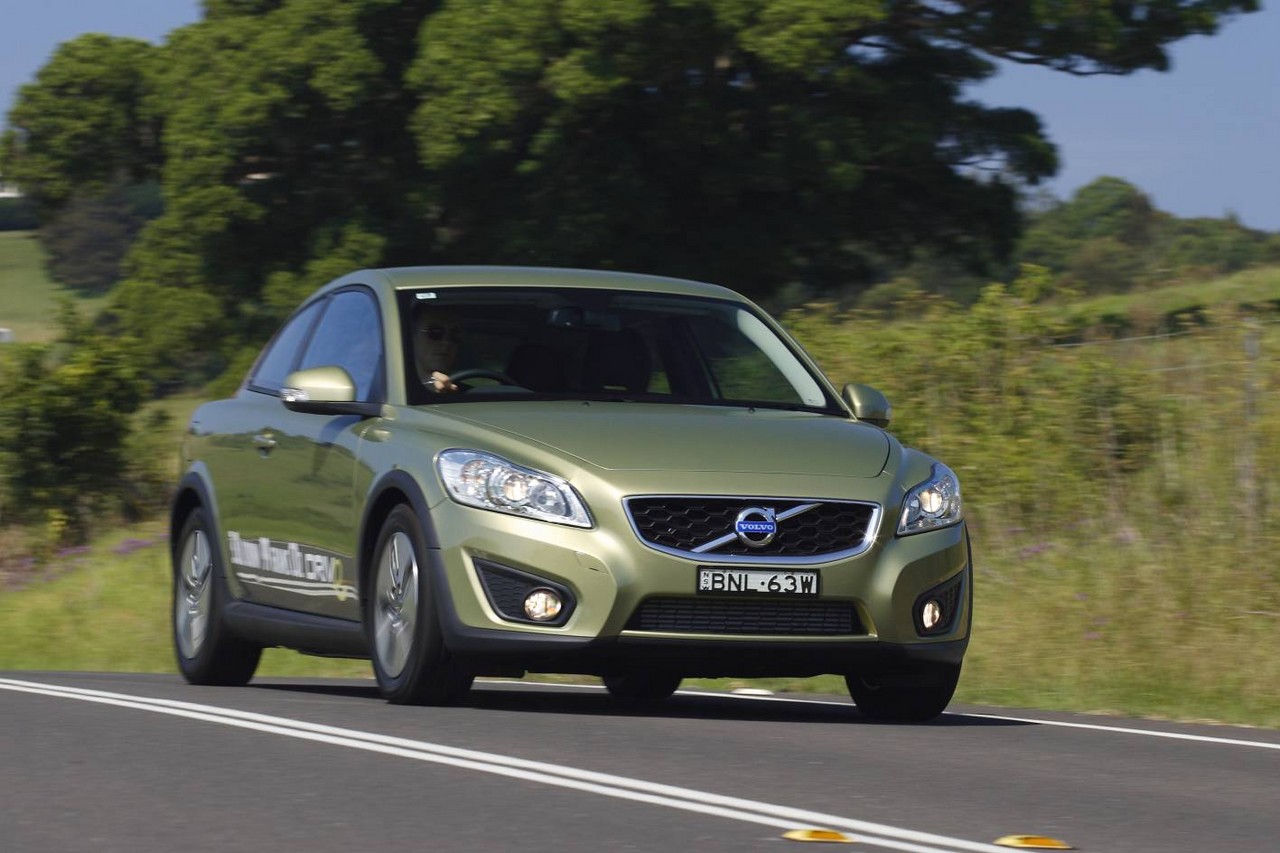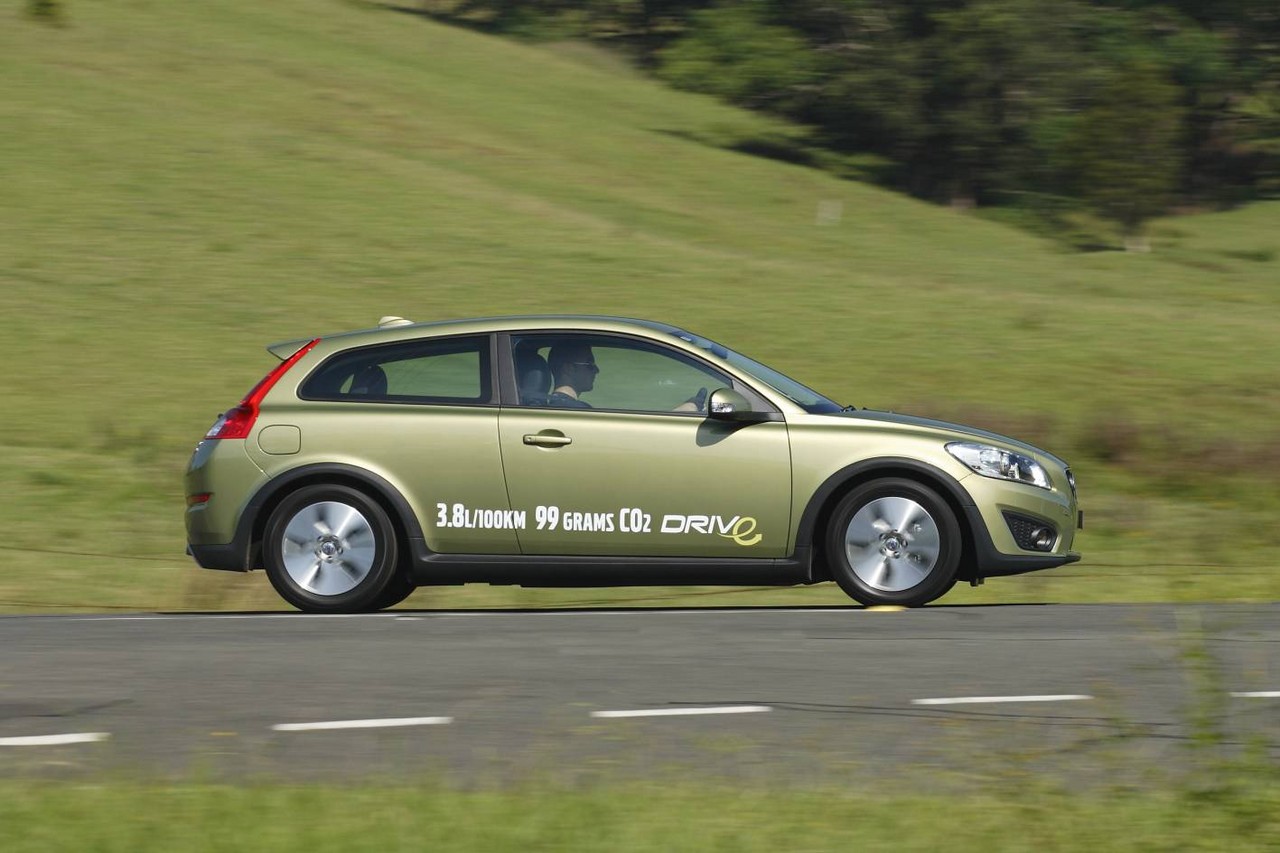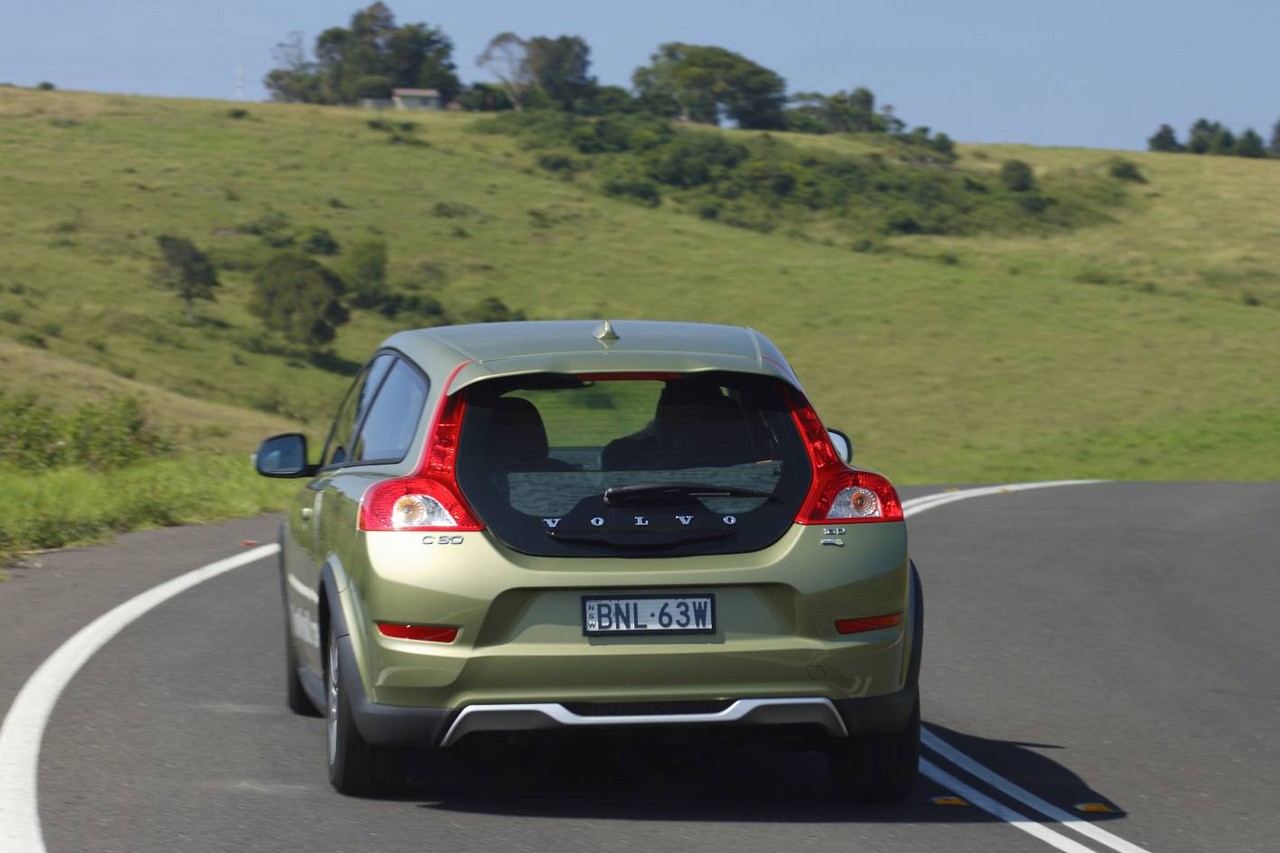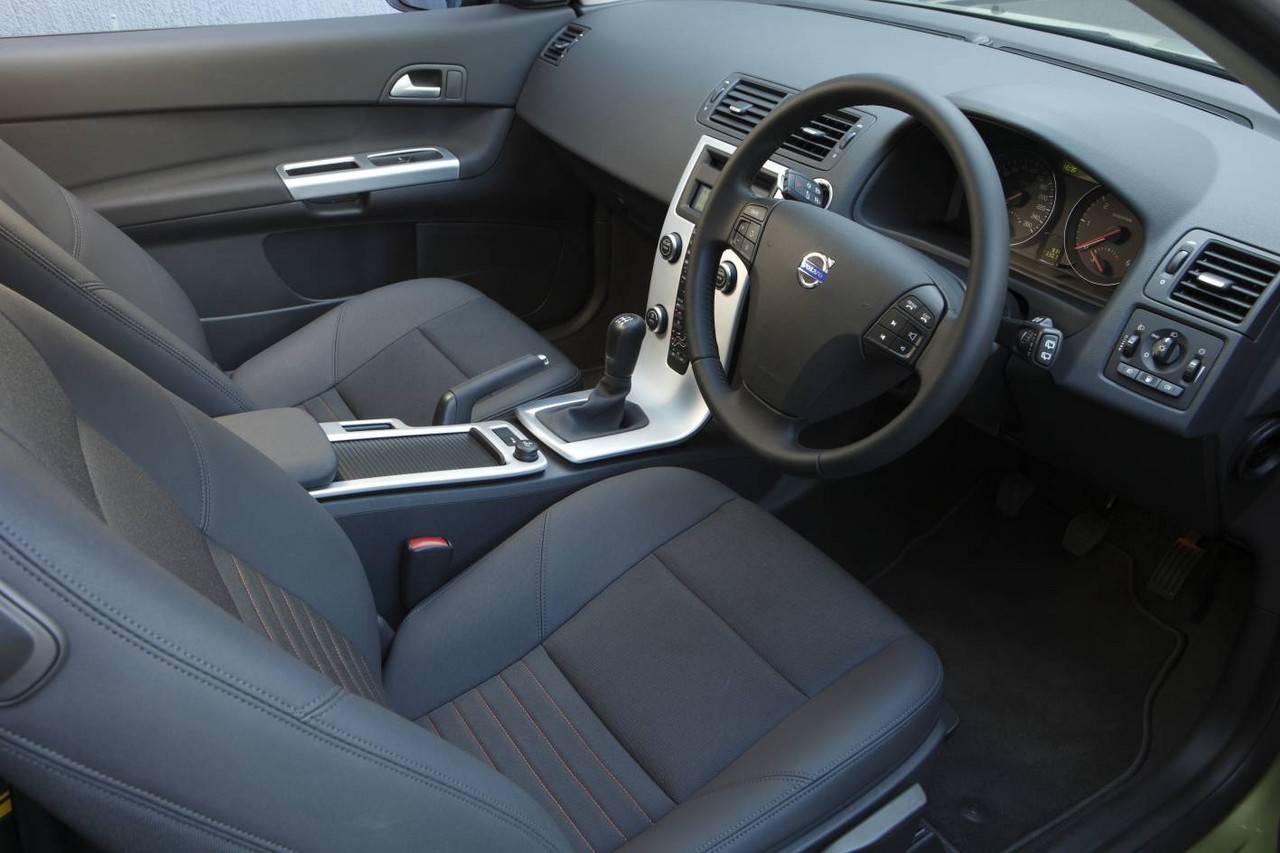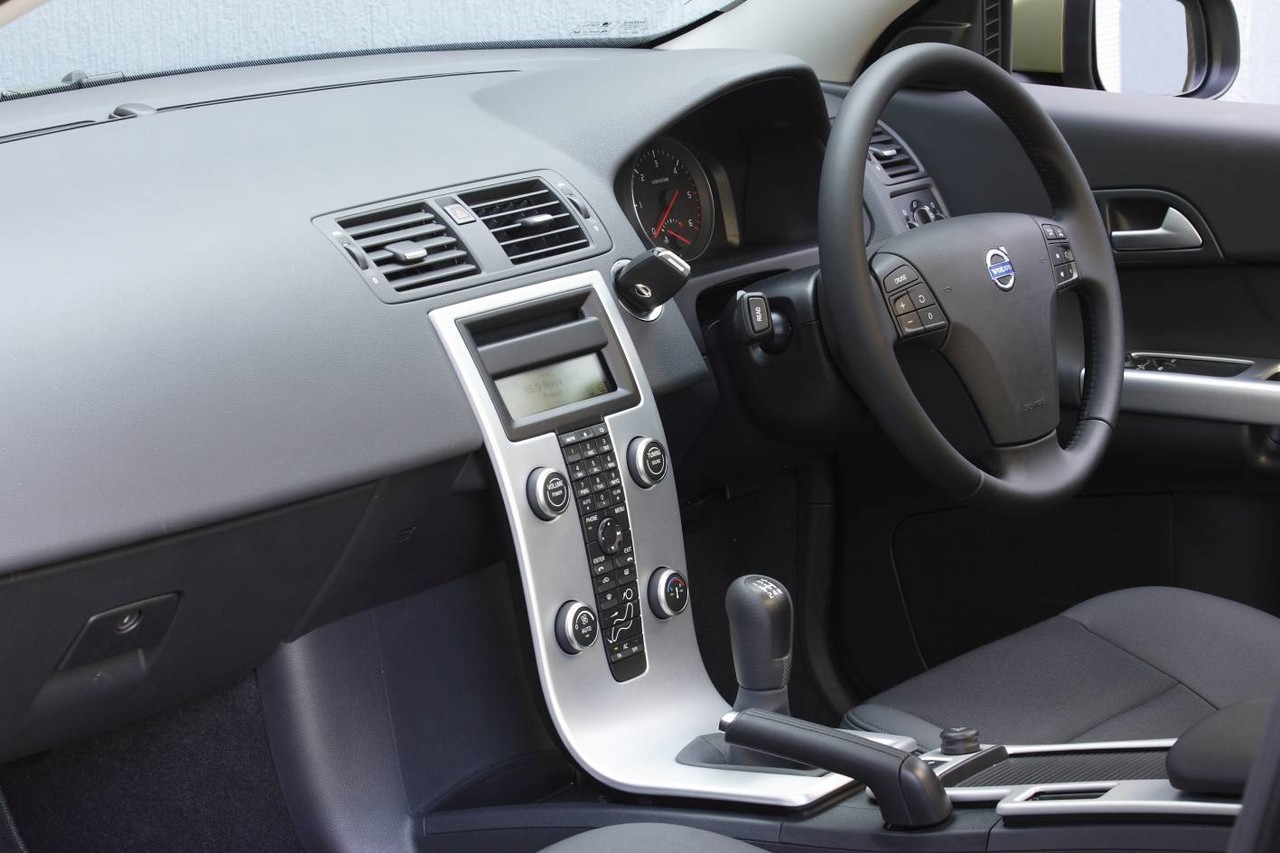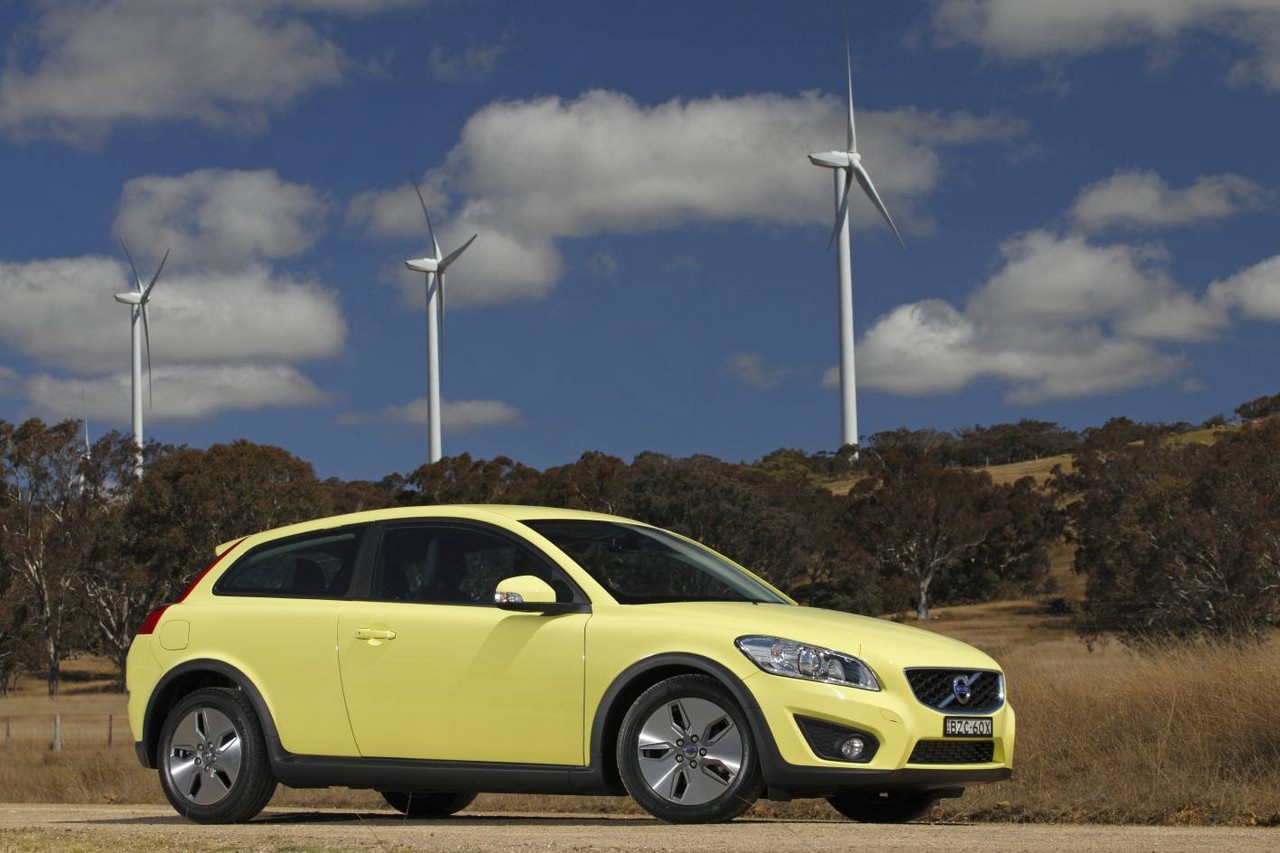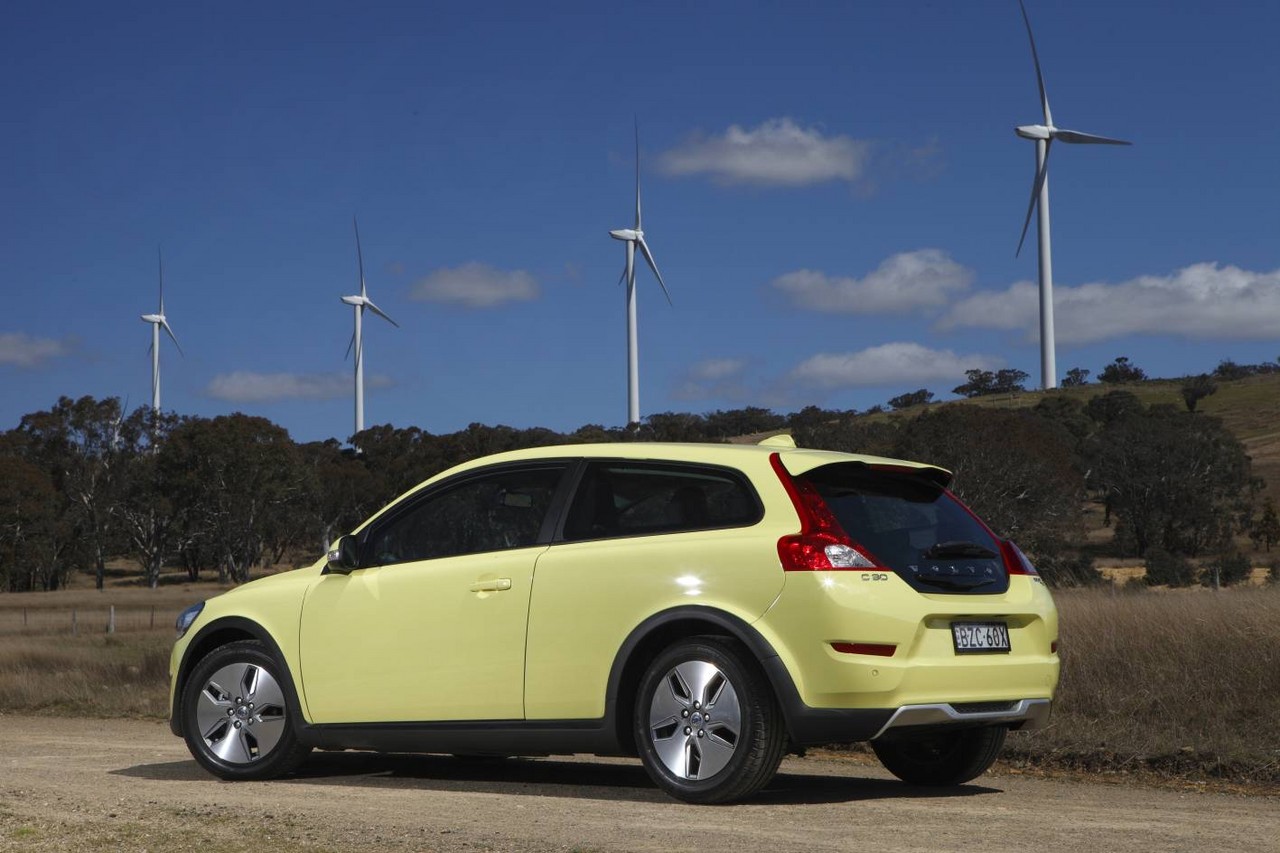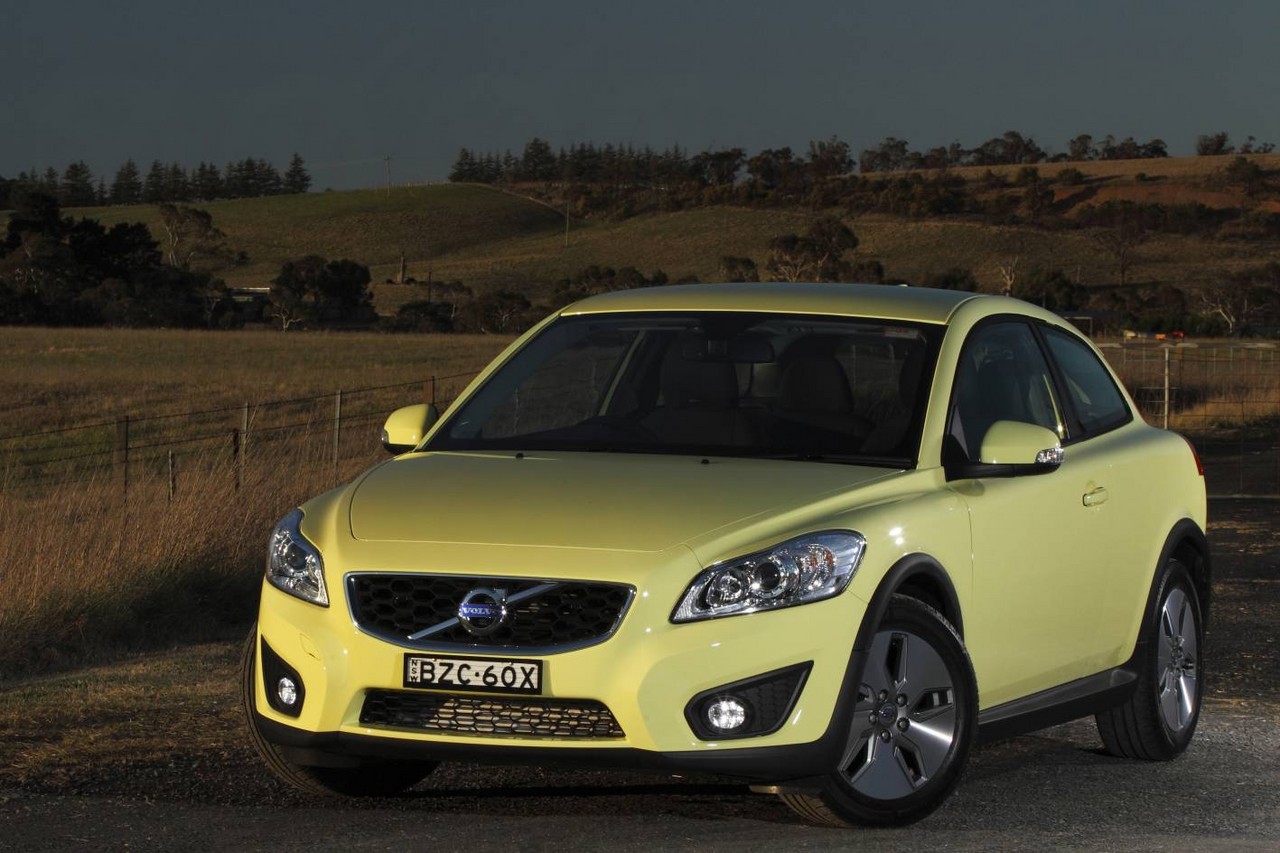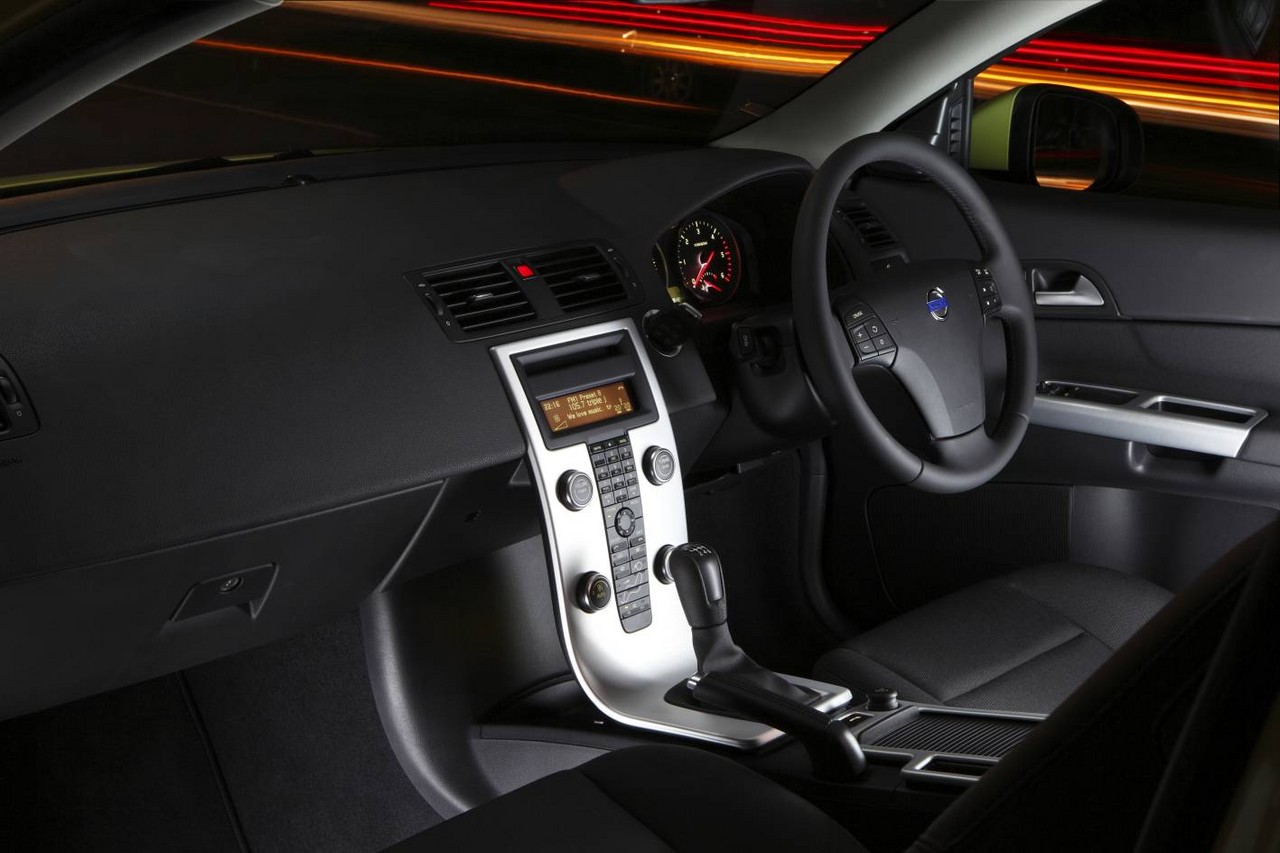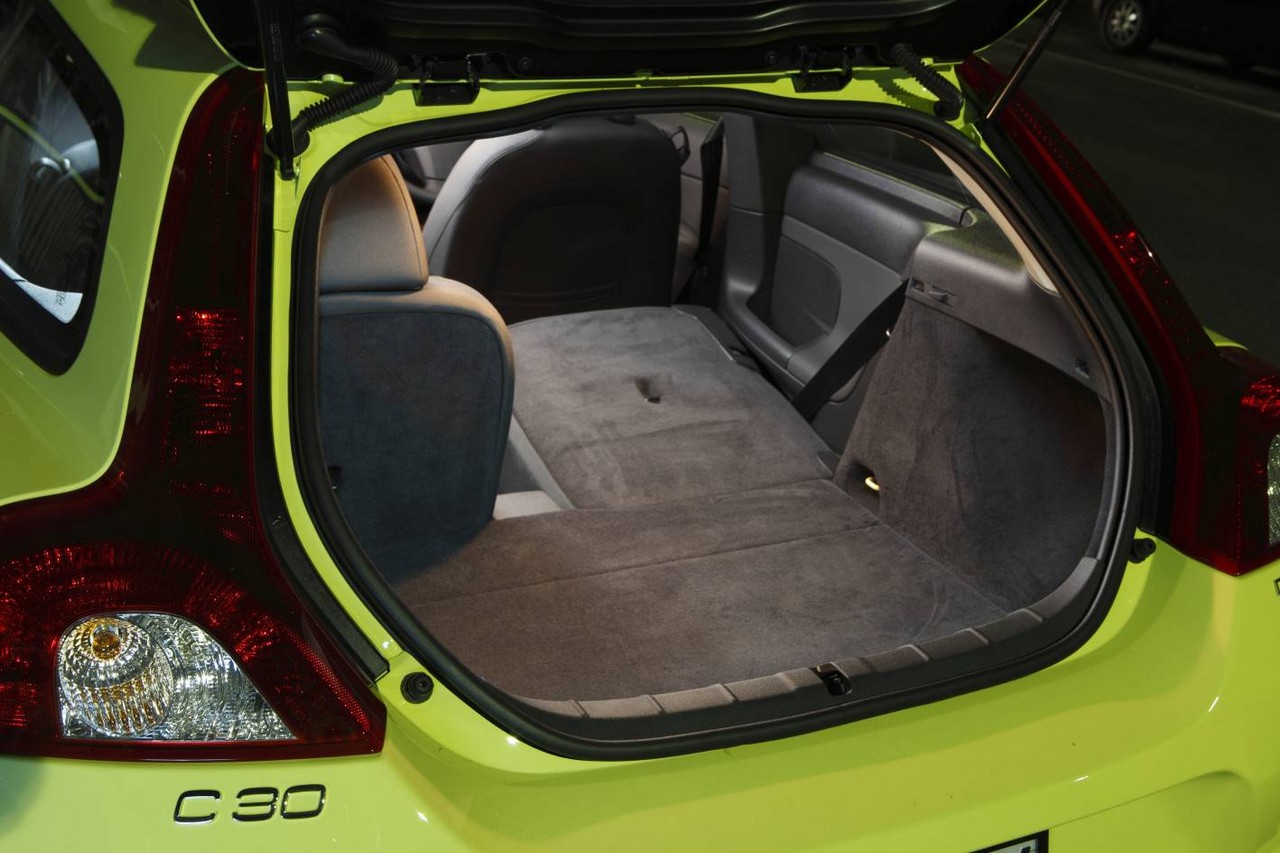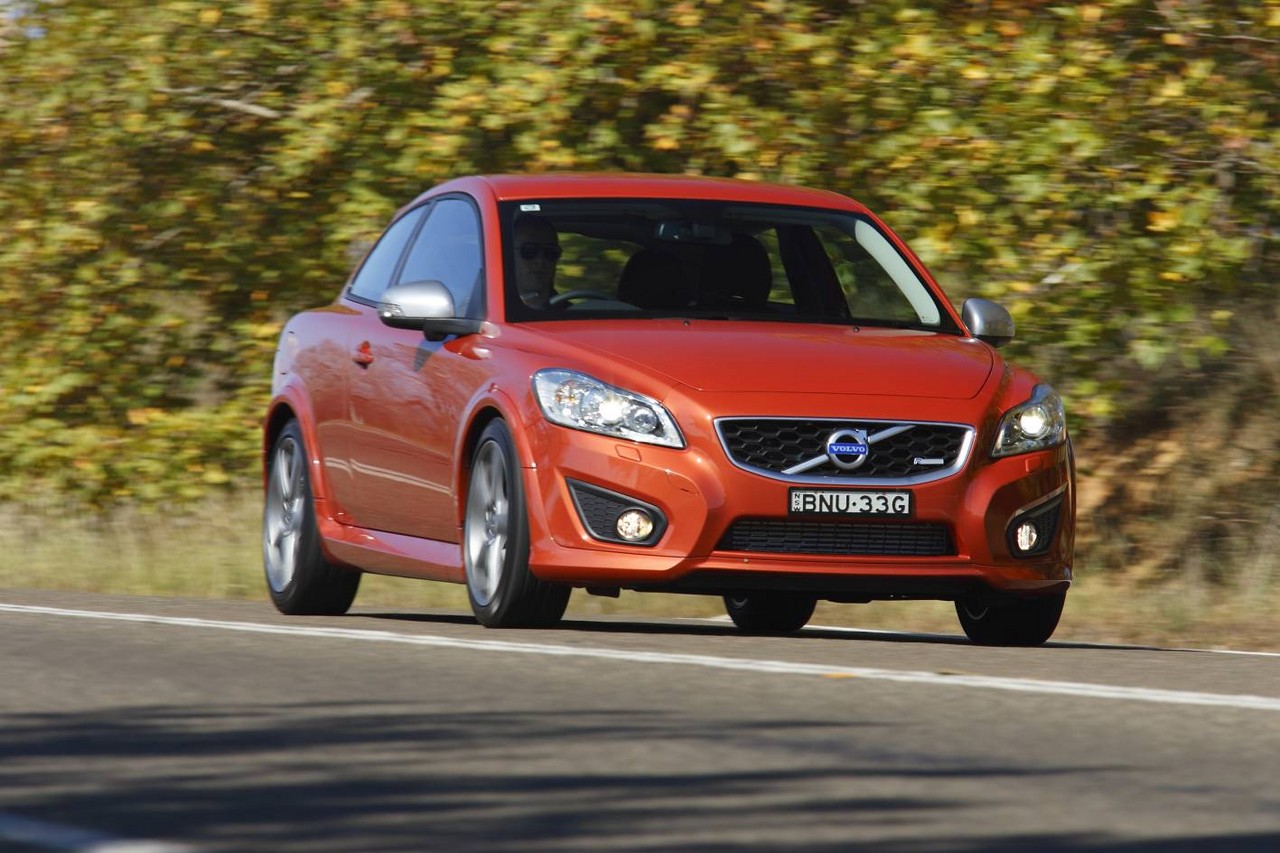
- Flexible 2.4-litre petrol engine
- For C30 T5, characterful 2.5-litre turbo petrol engine
- Comfortable and supportive front seats
- Accomplished ride/handling balance
- Direct steering provides good feel
- For C30 T5, suspension lacks compliance
- Doors are long and heavy
- Seatbelt sash may rub against driver’s neck
- Cramped driver’s footwell omits foot rest
- Shallow and narrow cargo space
- For C30 DRIVe, larg from 2.0-litre diesel engine
Review: Volvo Mk.1-I C30 (2007-10)
Overview
Released in March 2007, the Volvo Mk.1 Phase I (Mk.1-I) C30 was a three-door hatchback. Manufactured in Ghent, Belgium, the front-wheel drive Volvo C30 range initially consisted of 2.4, D5 and T5 variants. In 2009, however, the C30 D5 was replaced by the 2.0D; the full Mk.1-I C30 range is given in the table below.
B5244S4, B5254T3, D5244T8 and D4204T engines
Of the engines,
- The 2.4-litre B5244S4 five-cylinder petrol engine had an aluminium block and cylinder heads, fracture-split steel connecting rods, double overhead camshafts, four valves per cylinder, continuously variable valve timing for the intake camshaft and a compression ratio of 10.3:1;
- The 2.5-litre B5254T3 turbocharged petrol engine for T5 variants had similar properties but added a K04 Borg Warner turbocharger which provided peak boost pressure of 0.65 bar, an intercooler, continuously variable valve timing for the exhaust camshaft and had a compression ratio of 9.0:1. In 2008, the B5254T3 was replaced by the B5254T7 which had a slightly different turbocharger design and a reprogrammed ECU;
- The 2.4-litre D5244T8 (automatic) and D5244T13 (manual) turbo-diesel engines each had an aluminium block, common-rail direct injection (operating at 1600 bar), variable geometry turbocharger, cooled exhaust gas recirculation, double overhead camshafts, four valves per cylinder and a compression ratio of 17.3:1; and,
- The 2.0-litre D4204T turbo-diesel engine also had common-rail injection (albeit operating at 1800 bar), a variable geometry turbocharger, double overhead camshafts and four valves per cylinder, but was also fitted with piezo-electric injectors and had a higher compression ratio of 18.5:1.
Dimensions and suspension
Sharing its Ford C1 platform with the Volvo S40 and Volvo V50 , the Volvo C30 was 4252 mm long, 1782 mm wide, 1447 mm tall and had a 2640 mm long wheelbase. Furthermore, the C30 had MacPherson strut front suspension and independent, multi-link rear suspension (both with coil springs, gas-filled dampers and anti-roll bars).
| Years | Engine | Trans. | Peak power | Peak torque | |
|---|---|---|---|---|---|
| 2.4 S, 2.4 LE |
2007-10 | 2435 cc B5244S4 petrol I5 | 5sp man., 5sp auto |
125 kW at 6000 rpm | 230 Nm at 4400 rpm |
| D5 | 2007-09 | 2400 cc D5244T13 turbo-diesel I5 | 6sp man. | 132 kW at 4000 rpm | 400 Nm at 2000-2750 rpm |
| 2400 cc D5244T8 turbo-diesel I5 | 5sp auto | 132 kW at 4000 rpm | 350 Nm at 1750-3250 rpm | ||
| 2.0D | 2009-10 | 1997 cc D4204T turbo-diesel I4 | 6sp DCT | 100 kW at 4000 rpm | 320 Nm at 2000 rpm |
| T5 | 2007 | 2522 cc B5254T3 turbo petrol I5 | 6sp man., 5sp auto |
162 kW at 5000 rpm | 320 Nm at 1500-4800 rpm |
| 2008-10 | 2522 cc B5254T7 turbo petrol I5 | 6sp man., 5sp auto |
169 kW at 5000 rpm | 320 Nm at 1500-4800 rpm | |
| T5 R-Design | 2009-10 | 2522 cc B5254T7 turbo petrol I5 | 6sp man., 5sp auto |
Safety equipment
Standard safety equipment for the Volvo C30 included dual front airbags, front side airbags, full-length curtain airbags (i.e. for front and rear occupants), ABS, electronic brake force distribution, brake assist, traction control, active front seat head restraints, anti-submarining seats and front seatbelts with pretensioners and load limiters. The T5 was also fitted with electronic stability control, which became standard across the range in November 2008.
Euro NCAP testing
In Euro NCAP crash testing , the Volvo C30 received a five star adult occupant protection rating with a score of 33.99 out of 37. In the frontal impact test, there was a slight risk of serious leg injury for the front occupants. In the side impact test, the head curtain airbag was prevented from deploying fully by the child restraint system in the rear seat – this resulted in a one point deduction in an otherwise perfect score. Maximum points were also received in the pole test.
In 2009, Euro NCAP conducted additional whiplash tests to determine ratings under its updated testing regime. As such, the C30 received a five star safety rating which included a 91 per cent adult occupant protection rating and a 78 per cent child occupant protection rating.
Features: Volvo C30
Standard features for the Volvo C30 2.4 S, D5 and 2.0D variants included 16-inch alloy wheels, a six speaker sound system with CD player, climate control air conditioning, cruise control, front fog lights, 50/50 split and folding rear seats, a leather-wrapped steering wheel, remote central locking, power windows and mirrors, a tilt and reach adjustable steering wheel, a trip computer and an immobiliser.
The Volvo C30 2.4 LE was further equipped with an eight speaker sound system, leather seats, a power adjustable driver’s seat and power folding mirrors. Beyond this, the C30 T5 added 17-inch alloy wheels, bi-xenon headlights with washers and rain-sensing wipers.
Related links
- Volvo Newsroom: The New Volvo C30 – driving pleasure and safety (September 2006)
- Volvo Newsroom: Volvo C30 – model year 2008 (July 2007)
- Specifications: Volvo Mk.1-I C30 (November 2007)
- Volvo Newsroom: Volvo C30 – model year 2009 (May 2008)
- Volvo Newsroom: Volvo C30 – model year 2010 (March 2009)
- Heritage Models: Volvo C30 (2006-12)
Review: Volvo Mk.1-II C30 (2010-13)
Overview
Released in May 2010, the Volvo Mk.1 Phase II (Mk.1-II) C30 introduced a revised range with a slight facelift. As part of the update, the 2.4 LE was discontinued and the range was expanded with the introduction of the fuel-saving DRIVe variant. In August 2010, however, the 2.4 S and 2.0 D were discontinued.
Visually, the Mk.1-II C30 could be identified by its new front bumper and air intakes, a larger Volvo iron mark within the honeycomb grille, re-shaped headlights, front quarter panels and contoured rear bumpers. Inside, an ‘Oyster Burst Deco’ texture was introduced for the centre stack and door panel inlays, while there was also honeycomb-style aluminium interior trim.
C30 DRIVe: D4164T engine
The DRIVe was powered by a 1.6-litre D4164T turbo-diesel engine which had common-rail direct injection, a variable geometry turbocharger, intercooler, double overhead camshafts, four valves per cylinder, exhaust gas recirculation valve, diesel particulate filter and a compression ratio of 18.3:1; a five-speed manual transmission was fitted as standard.
To minimise fuel consumption, the DRIVe variant had a lowered ride height and aerodynamic enhancements in the form of a revised grille, front airdam, under body panels, wind deflectors and a rear spoiler.
| Years | Engine | Trans. | Peak power | Peak torque | |
|---|---|---|---|---|---|
| 2.4 S | 2010 | 2435 cc B5244S4 petrol I5 | 5sp man., 5sp auto |
125 kW at 6000 rpm | 230 Nm at 4400 rpm |
| 1.6D DRIVe | 2010-13 | 1560 cc D4164T turbo-diesel I4 | 5sp man. | 80 kW at 4000 rpm | 240 Nm at 1750 rpm |
| 2.0D | 2010 | 1997 cc D4204T turbo-diesel I4 | 6sp DCT | 100 kW at 4000 rpm | 320 Nm at 2000 rpm |
| T5 | 2010 | 2522 cc B5254T7 turbo petrol I5 | 6sp man., 5sp auto |
169 kW at 5000 rpm | 320 Nm at 1500-4800 rpm |
| T5 S, T5 R-Design |
2010-13 | ||||
| T5 Lifestyle | 2011-13 |
Safety equipment
Compared to its Mk.1-I predecessor, standard safety equipment was unchanged. However, the Volvo Mk.1-II C30 was fitted with Volvo’s ‘Emergency Brake Lights’ which would flash rapidly in emergency braking situations when the vehicle’s initial speed was greater than 60 km/h. Once the vehicle’s speed was below 10km/h, the brake lights would stop flashing and the hazard lights would be activated.
Features
Standard features for the Volvo Mk.1-II C30 were extended to include a power adjustable driver’s seat. The newly-introduced DRIVe variant was similarly equipped to the 2.4 S.
C30 T5: R-Design and S editions
Compared to the standard C30 T5, the C30 T5 R-Design was distinguished by its 17-inch ‘Cratus’ alloy wheels with 30 per cent stiffer springs, firmer monotube dampers, stiffer stabiliser bars and faster-ratio steering. Visually, the T5 R-Design could be identified by its front and rear spoilers, body-coloured side skirts and chrome-plated exhaust pipes. Inside, there were R-Design emblems (including the embossed front seats), aluminium sports pedals and a blue speedometer and tachometer. The T5 R-Design was also fitted with rear parking sensors.
In August 2010, an S edition of the T5 variant was released. Compared to the T5 R-Design, the C30 T5 S was fitted with a six speaker sound system (as opposed to an eight speaker unit) and omitted the R-Design’s upgraded suspension package, leather seats, bi-xenon headlights, sports pedals and body kit. At this time, Bluetooth connectivity was made standard for the T5 and the R-Design edition received 18-inch alloy wheels.
October 2011: C30 update
In October 2011, standard features for the Volco C30 extended to include rear parking sensors and an eight speaker sound system. Furthermore, the C30 T5 Lifestyle model was released; compared to the T5 S, the Lifestyle edition was further equipped with leather seats and directional bi-xenon headlights with washers.
C30 T5 R-Design – Polestar tuning
From April 2012, Volvo could apply Polestar tuning software to the C30 T5 R-Design which increased peak power by 15 kW to 184 kW and peak torque by 50 Nm to 370 Nm.
Related links
- Specifications: Volvo Mk.1-II C30 (May 2010)
- Technical Specifications: Volvo Mk.1-II C30 (July 2010)
- Volvo Newsroom: Volvo C30 – sporty new front (January 2010)
- Volvo Newsroom: Volvo C30 R-Design (January 2010)
- Volvo Newsroom: Volvo C30 – model year 2011 (June 2010)
- Volvo Newsroom: Volvo C30 – model year 2012 (May 2011)
- Volvo Newsroom: Volvo C30 – model year 2013 (August 2012)
- Wikipedia.org: Volvo C30
